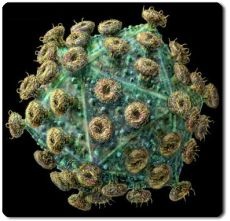New assay to identify acute HIV infections
A new HIV antigen-antibody combination assay, currently available in Europe, can be useful for high-volume screening to identify individuals with acute HIV infection, who would be missed by traditional HIV antibody tests, according to research presented by Johns Hopkins University, Abbott and others at the 16th Conference on Retroviruses and Opportunistic Infections (CROI).

"Those with recent HIV infections who have not yet developed an HIV
antibody response are a major driver of the global HIV epidemic," said John
Hackett, Ph.D., from the Global HIV Surveillance Program at Abbott. "The
current method for detection of acute infections is expensive and labor-
intensive pooled nucleic acid testing (NAAT). The combination assay
represents a reliable and cost-effective alternative with important benefits
for HIV prevention strategies."
Acute HIV infection, the early phase of infection when symptoms begin to
emerge, cannot be detected by most routinely used serological HIV tests.
Conventional HIV tests detect HIV-specific antibodies in blood or oral fluids
that are produced by the immune system during seroconversion or the
development of detectable antibodies, which occurs approximately 22 to 25 days
after initial infection. Therefore, a person infected very recently may
receive an HIV-negative result using conventional HIV tests.
Testing for the antigen reduces the "window period" in which an individual
may have been exposed to HIV and have a reactive test result. This means that
individuals exposed to HIV may test reactive for the antigen, but may not test
reactive to the antibody.
Johns Hopkins and Abbott Study Results
In the study by Johns Hopkins and Abbott, blood samples were collected
every six months from men who have sex with men (MSM) participating in the
U.S. Behavioral Intervention Study (EXPLORE). The men were HIV antibody
negative at enrollment in the study. The previous seronegative specimens from
patients who subsequently tested HIV antibody positive were tested
individually with two different HIV RNA assays. Those determined positive by
both methods were classified as acute infections. The specimens were then
tested with the Abbott ARCHITECT(R) HIV Ag/Ab (antigen/antibody) Combo assay
and two third-generation HIV antibody tests.
The Abbott combination assay detected 61.9 percent (13) of the acute
infections. Only 14.3 percent (3) of the acute samples were identified as
positive by one of the third-generation antibody tests. There were a total of
21 acute infections among 217 samples from seronegative individuals.
"The HIV Combo assay detected nearly two-thirds of early, acute HIV
infections in a high-risk population, suggesting that this test can be useful
for high-volume public health outreach screening to identify acute HIV
infections," Hackett said.
University of Washington, Kings County and Seattle Public Health
In another study presented at CROI, researchers from the University of
Washington, Kings County and Seattle Public Health tested 14,005 MSM with HIV
antibody tests from 2003 through 2008. Overall, 328 individuals (2.3 percent)
were positive for HIV antibodies, and 36 of those who tested negative
were classified as positive after pooled HIV RNA testing. The HIV antibody
tests detected 90 percent of the infected samples.
Sixteen of the 36 samples that tested negative for HIV antibodies and
positive with the RNA test were then tested with the Abbott HIV Ag/Ab Combo
assay. Of the 16 RNA-positive samples, 15 (94 percent) were detected by the
Abbott HIV/Ab Combo assay. "This study indicates that the HIV antigen-
antibody combination assay could be an effective alternative to NAAT for
identifying acute HIV infections," Hackett said.
The Abbott ARCHITECT(R) HIV Ag/Ab Combo assay is currently in development
and not available in the United States.
About ARCHITECT
With its extensive menu of diagnostic tests, user-friendly software and
advanced sample management capabilities, the ARCHITECT(R) family and the
currently marketed flagship analyzer, ARCHITECT(R) ci8200(R), meet the needs
of today's diagnostics laboratory by enhancing workflow and productivity.
ARCHITECT instruments are designed with laboratory-focused features such as
the capability to prioritize emergency tests, the ability to use common
reagents among platforms and sample monitoring. These features not only
minimize training, but also reduce inventory costs and sample contamination
potential, leading to better results for laboratories, physicians and,
ultimately, patients.
11.02.2009











